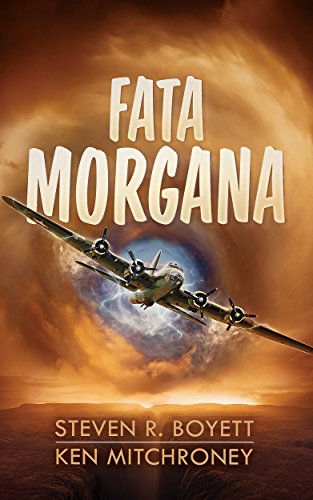
![]() Fata Morgana by Steven R. Boyett & Ken Mitchroney
Fata Morgana by Steven R. Boyett & Ken Mitchroney
It’s 1943, at the height of the air war during World War II. US Air Force Captain Joseph Farley and his crew of nine men fly a B-17 bomber on missions out of England, bombing German factories and other military targets. On their last mission their bomber Voice of America, a never-ending source of problems (“fixing this one’s like taking a gator to the vet. You’re just making it better so it can try to kill you again”) finally bit the dust permanently, and the crew is assigned a brand new B-17F bomber, which they christen Fata Morgana after an unusual type of mirage, along with a new ball turret gunner, Sergeant Martin Proud Horse, a Native American of the Lakota tribe. One of the men, Shorty, is a gifted artist who paints a sorceress type of woman on the nose of the Fata Morgana, following Captain Farley’s detailed description of a woman who haunts his dreams.
Their next mission is to bomb a German munitions factory, and on this run the Fata Morgana and its crew, under heavy fire from German fighter planes, are drawn into a mysterious vortex near the factory. They emerge on the other side in an unrecognizable world, a barren, blackened plain where there are only two small, domed cities that are engaged in a bitter war with each other. The Fata Morgana is attacked by a huge winged monster, but they manage a relatively controlled crash landing. Then the crew promptly loses control of their wrecked plane to soldiers of one of the warring cities and is taken in by the other group, led by a woman who is the image of the painting on their plane. The crew tries to adjust to life in this technologically advanced but decaying world. Still, their ultimate mission is to recover and repair their plane and make their way back to their own world, to fulfill their duty despite almost insurmountable obstacles.
Fata Morgana (2017) reads as a retro type of science fiction novel, and not just because the main characters are WWII military men. It’s a straightforward, action-packed story with a focus more on the adventure and excitement than on characterization or depth. Captain Farley’s romance (such as it is) is courtly and sweet, if a little trite. There are detailed and true-to-life descriptions about B-17 bombers and bombing runs, particularly in the first eighty pages, which part reads like a straight WWII historical novel. For the most part this is a hard science fiction novel, but there’s a slight “there are more things in Heaven and Earth, Horatio” element to a couple of aspects of this novel that edges it just a bit toward fantasy. The dénouement managed to remind me of both the ending of the WWII memoir Band of Brothers and the love-beyond-time element from the movie Somewhere in Time.
Because the main characters are from the 1940s, most of them have outdated views toward, for example, women and minorities ― specifically, Sergeant Proud Horse. Steven Boyett and Ken Mitchroney don’t shy away from giving these men dialogue that is true to the era, but may make some modern readers cringe. When Proud Horse introduces himself and tells his new crew that he’s Lakota (which means nothing to the men) and an Indian, the flight engineer greets him with “How, Chief” and another crewman asks him if he’d left his teepee to come to England and shoot Germans. Proud Horse responds with broad humor and a sizzling baseball pitch that earns him general respect, though the “Chief” nickname lingers. To give them credit, the men do prove to be somewhat open-minded when they find themselves in a world where women are treated equally.
With a crew of ten men, it’s understandable that not all of them are distinguishable personalities, but Boyett and Mitchroney did a reasonable job of making several of them memorable, even if they are more or less familiar types. For example, there’s the brave and noble leader, the loyal lieutenant, and the engineer who’s improbably brilliant in figuring out completely unfamiliar technology. (How does he manage to hack a robot when he’s never seen a computer before?)
I have to admit I was initially rolling my eyes when the Fata Morgana crew landed among English-speaking people, but Boyett and Mitchroney eventually disclose the reason for that, and the overall plot is fairly well-constructed. I always appreciate it when elements that initially seem random eventually become relevant to the plot in ways that are surprising but logical. The one exception to the lucid story-telling is a climactic scene with some mysterious technology that seems to bend time and space. It was clearly supposed to be confusing, but it veered a little too far into the incomprehensible. On the other hand, the winged monster, a cyborg-like being called the Typhon, felt terrifyingly real, especially when some of the characters get to see it up close.
Fata Morgana is not a book that is likely to appeal to every science fiction fan, but if you’re interested in WWII history or like vintage-type hard SF, it’s worth taking the flight with Captain Farley and his crew.



This reminds me. I want to read Addie LaRue.
We’re in total agreement David!
I felt just the same. The prose and character work was excellent. The larger story was unsatisfying, especially compared to…
Hmmm. I think I'll pass.
COMMENT Was I hinting that? I wasn't aware of it. But now that you mention it.... 🤔